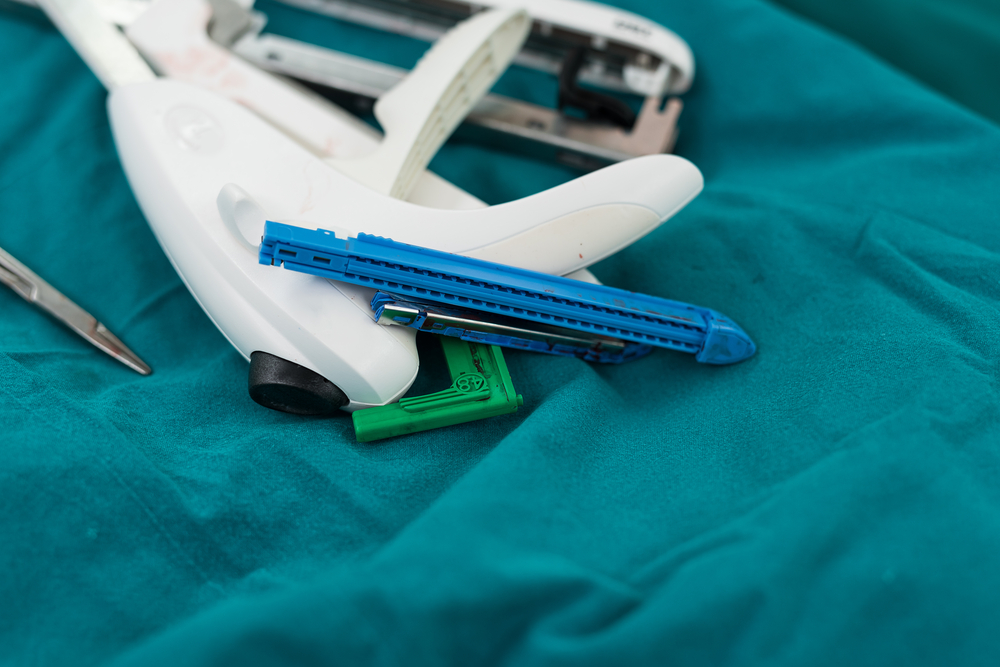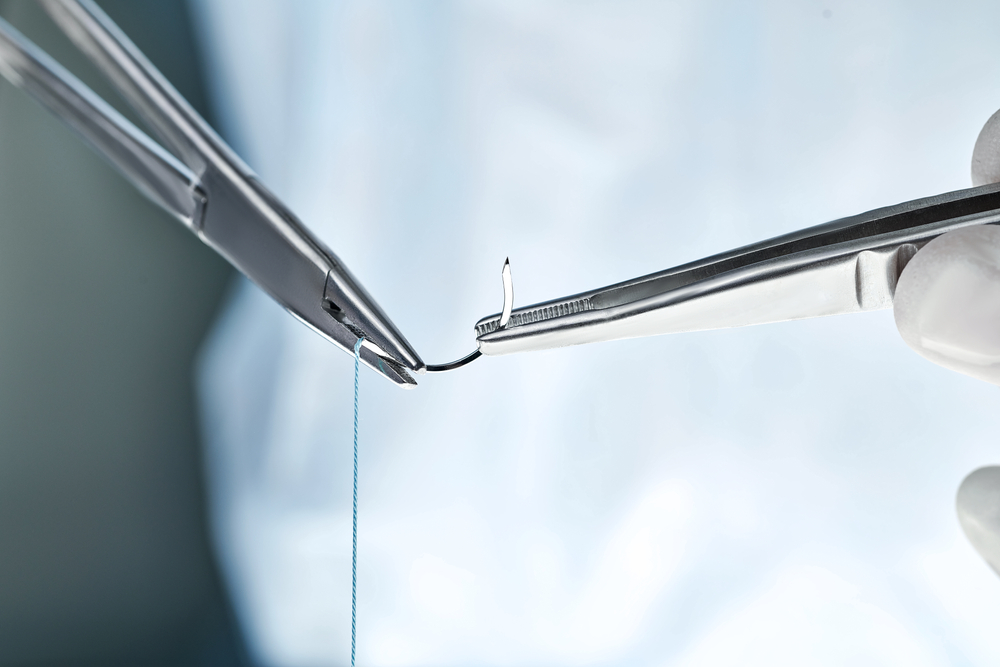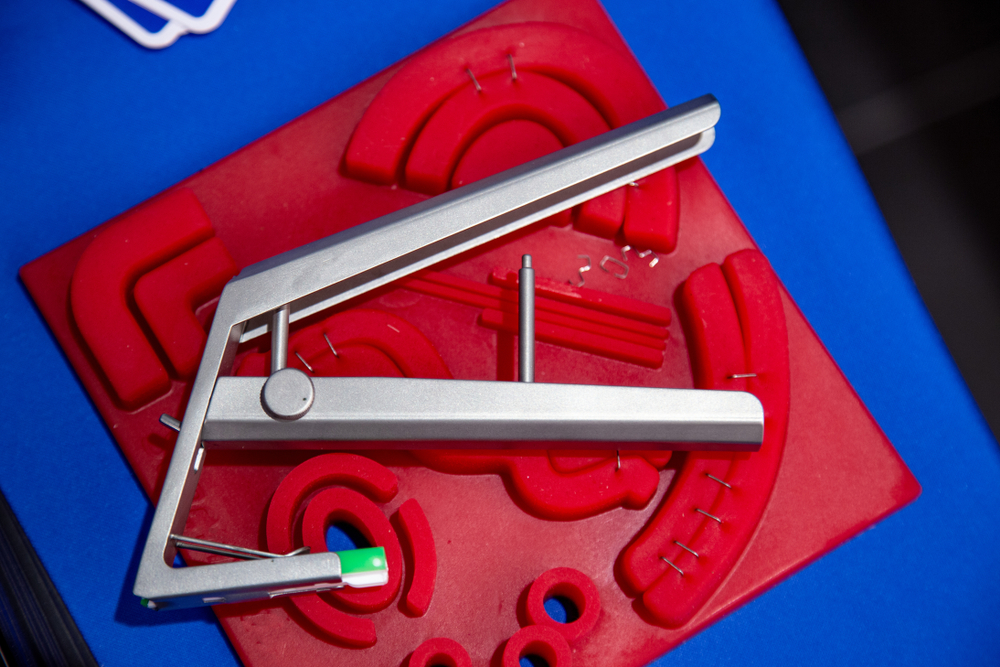What Are Surgical Staplers?
Surgical staplers are medical devices that may be used in place of sutures to close surgical wounds or incisions. The staplers themselves are often made of plastic and can either be disposable or reusable. However, they don’t look like regular office staplers. Instead, they’re similar in appearance to commercial-grade construction staplers. As for the staples, they’re often made out of either steel or titanium for maximum strength.
Why Are Surgical Staplers Used?
In general, surgical staplers are used for larger surgical wounds both internally and externally that stitches may not be able to handle. The C-section is a common procedure for which surgical staples are used, as it may help reduce scar tissue and healing time. Staples may also be used to connect or reconnect organs within an organ system — such as after removing a part of the digestive tract to reconnect it.

Some doctors prefer staples over sutures, arguing that they are faster (staples are placed instantly) and easier to use than sutures. The FDA also lists low infection risk and minimal tissue reaction as advantages of this method. Additionally, surgical staple strength may offer advantages for larger surgical wounds.
Caring For Surgical Staples
Surgical staples must be removed (discussed below). However, they remain in your body for up to two weeks, depending on the procedure.
Caring for surgical staples correctly during this time is vital to healing properly and minimizing the chance of complications occurring.
Surgical Staple Removal
Unlike sutures, the body does not absorb most surgical staples (excluding the polylactide-polyglycolide copolymer staples). Internal staples are sometimes designed to be left inside the body permanently, or an absorbable type of staple is used.
Aside from these cases, a doctor must remove the staples after sufficient healing has occurred. Removal is usually not painful, but patients should not attempt to do so themselves. Removal must be performed in a sterile environment, and doctors use a special tool to remove them.
Related: Surgical Staplers & Staples: What You Need to Know
Common Surgical Stapler Problems
Despite the benefits of surgical staplers discussed above, patients may encounter numerous problems during the staple application, post-op recovery, or removal. These include:
- Opening of the wound
- Poor staple application (too much or too little force)
- Incorrect staple placement location
- Jammed, misfired staple, or failure to fire a staple
- Damaged, broken, or malformed staples
- Using incorrectly-sized staples given the application
- Failure to remove a staple that is designed to be removed
- Allergic reaction to staple material
Any of these and other problems could increase recovery time and pain during recovery at best. At worst, they expose the patient to significant health risks.
Serious Injuries That Surgical Staplers Can Cause
Given the potential problems posed by surgical staplers, they can lead to numerous serious injuries. This is especially true considering that surgical staples are often used inside the body. Even the smallest error could have a dramatically negative impact on the patient.
Some major and even life-threatening complications surgical staples may contribute to include:
- Allergic reactions to staple material
- Blood clots
- Fistula
- Infection/sepsis
- Internal organ or tissue damage/tearing
- Internal bleeding
The Underreporting of the Risks of Surgical Staples
Despite the various risks and problems surgical staples can post to patients, the FDA currently considers surgical staplers for internal use as Class I (low-risk) devices (although that may change). This is the lowest-risk category of medical devices.
To put that into perspective, surgical staplers are in the same class of tools as bandages, tongue depressors, and non-electric wheelchairs. To be fair, handheld surgical instruments generally fall under Class I. However, the number of reported surgical stapler/staple malfunctions, injuries, and even deaths make some question why the device is still in Class 1.
41,000 adverse events pertaining to surgical staplers and staples were reported to the FDA’s database from January 1, 2011, to March 31, 2018:
- 366 deaths
- Over 9,000 serious injuries
- Over 32,000 malfunctions
However, on March 7, 2019, Kaiser Health News (KHN) reported that the FDA withheld valuable information from the public — and even from doctors — regarding negative incidents pertaining to medical devices, including surgical staples. It turns out that the total number of surgical stapler incidents from 2011-2018 totaled 110,000.
The FDA has proposed reclassifying surgical staplers from Class I to Class II in light of these issues. Such a reclassification would require special controls surrounding the use of these devices. Additionally, the FDA would have to perform a premarket review of any new surgical stapler or staple product before the manufacturer can begin selling it.
However, this proposal is still pending at the time of writing.

A Timeline of FDA Action
January 1, 2011 — March 31, 2018: Surgical Stapler and Staple Reports
The FDA receives over 41,000 medical device reports about surgical staplers and staples for internal use over this 7.25 year period. This data is available in a public database.
March 7, 2019: The First Kaiser Health News Story About Medical Devices
Kaiser Health News publishes its article about the hidden reporting of 1.1+ million medical device incidents related to about 100 medical devices in a database that the public could never access. These reports happened between 2016 and 2019.
March 8, 2019: FDA Warns About Increased Adverse Events
The FDA sends health care providers a letter warning about increased adverse event numbers associated with surgical staplers and staples used internally.
April 11, 2019: Ethicon Recall
After reports of Ethicon circular staplers and staples malfunctioning, Ethicon issued a recall for its staplers. The FDA classifies this as a Class I recall (no relation to Class I, II, or III devices).
April 23, 2019: Manufacturer Guidance
The FDA creates draft guidance to help manufacturers add information regarding medical device hazards, limitations, and proper usage to each device’s labels.
April 24, 2019: Reclassification Proposal
The FDA submits its proposed rule to reclassify surgical staplers and staples for internal use from Class I to Class II devices.
May 30, 2019: FDA Public Meeting
The FDA gathers expert input from surgeons regarding potential surgical stapler/staple reclassification by hosting an open public meeting with the General and Plastic Surgery Devices Panel of the Medical Devices Advisory Committee.
May 30, 2019: Hidden Surgical Stapler Incidents Discovered
Kaiser publishes another article detailing that between 2011 and 2018, about 56,000 surgical stapler/staple reports were submitted to the hidden ASR database.
June 5, 2019: Another Letter to Healthcare Providers
The FDA sends a letter warning about the injury and death risks and statistics to anyone who regularly uses surgical staplers in procedures. The letter also offers some suggestions to reduce injury.
Surgical Stapler Lawsuits and Recalls
Surgical Stapler Manufacturers
Here are the big surgical stapler manufacturers:
- Covidien (part of Medtronic)
- Ethicon US (part of Johnson & Johnson)
- 3M
- B. Braun Melsungen AG
- Cardica
- Care Fusion Corporation
- CONMED
- Frankenman International
- Meril Life Science
- Purple Surgical
- Smith & Nephew
- Stryker
- U.S. Surgical
- Welfare Medical
- Reach Surgical
- Zimmer Biomet
Recalls
Here are some major surgical stapler recalls, along with the reason for the recall:
2013 – Echelon 60mm Endoscopic Linear Cutter Reloads Black (Manufactured by Ethicon)-Potential for reload damage that could cause staples to misfire
2015 – Endopath Echelon Flex Powered Vascular Staplers with Advanced Placement Tip and White Reloads (Manufactured by Ethicon)-It was discovered that some staplers may not always insert a full line of staples when the device is fired
2018 – EEA Hemorrhoid and Prolapse Stapler Sets With DST” Series Technology (Manufactured by Medtronic)-Potential for improper welding of the yellow staple guide to the instrument, which can result in improper staple formation and subsequent injury.
2018 – Endo GIA “Auto Suture” Universal Articulating Loading Unit (Manufactured by Medtronic)-Missing components that could affect staple alignment contribute to injuries in five patients.
2019 – Endo GIA Articulating Reloads with TriStaple Technology (Manufactured by Medtronic)-Staplers had missing components that could affect staple alignment in devices.
2019 – Endo-Surgery Curved Intraluminal Stapler with Adjustable Height Staples, Endo-Surgery Endoscopic Curved Intraluminal Stapler with Adjustable Height Staples (Manufactured by Ethicon)-Device can misfire and injured two patients.
Lawsuits
Here are some major lawsuits initiated and won by plaintiffs over surgical stapler issues.
$5 Million in Damages For Wrongful Death Related
In 2012, a Pennsylvania family brought a lawsuit alleging that one of their loved ones died because a surgical stapler failed to seal the surgical area properly during a gastric bypass procedure.
The jury in the case awarded $5 million in damages to the family.
$80 Million Awarded in Stapler Misfire Case
A California woman named Florence Kuhlmann and her husband John Perkins brought a lawsuit alleging a stapler misfire led to injuries that required two weeks of hospital care and permanent colostomy bag use.
The jury awarded Kuhlman $80 million in total — $70 million of which were punitive damages.
$5.5 Million Settlement For Wrongful Death Related to Surgical Staplers
A man named Ryan Strange sued several parties for the 2013 death of his wife, April Strange, after she underwent surgery where a surgical stapler was used:
- Memorial Medical Center in Springfield, Illinois
- Southern Illinois University School of Medicine’s group practice doctors
- Covidien (now part of Medtronic)
The surgical staples used failed to properly seal the wound and cut a blood vessel, which caused April to lose a substantial amount of blood and eventually die.
All parties agreed to share in the $5.5 million settlement, with Covidien paying $250,000.
Surgical Staple Injury: Potential Compensation
 Medical device manufacturers are required to meet specific safety standards in the design, manufacture, and use of their products to protect both medical practitioners and patients. If they fail to do so, they can be held legally liable by individuals who experience injury from the manufacturer’s device.
Medical device manufacturers are required to meet specific safety standards in the design, manufacture, and use of their products to protect both medical practitioners and patients. If they fail to do so, they can be held legally liable by individuals who experience injury from the manufacturer’s device.
Here are some potential monetary damages you may be awarded in a successful surgical stapler injury lawsuit:
- Lost wages
- Lost ability to earn future income
- Loss of consortium
- Loss of enjoyment of life
- Past and future medical expenses
- Pain and suffering
- Funeral expenses for stapler injury-related deaths
- Punitive damages won from the manufacturer
Keep in mind that lawsuits about surgical staplers and staples have statutes of limitations. This means you have a limited time under which the law allows you to file a suit after either the injury occurs or you become aware of that injury. You will not be able to pursue a lawsuit once this statute of limitations expires.
Statutes of limitations vary by state. Make sure you know the statute of limitations in your location, and, if you believe you have a case, contact a surgical staple injury attorney right away to avoid missing the statute of limitations deadline.
Preparing For and Filing a Surgical Stapler Lawsuit
Has a surgical stapler injured you or a loved one? You might have a surgical stapler case. At a minimum, you want to work with a lawyer experienced in personal injury and defective product lawsuits. Some attorneys have experience and good track records, specifically with surgical lawsuits as well.
With this in mind, spend some time talking with each attorney you come across. Ask them as many questions as you need to make a decision. Doing so will help you feel more confident in your ability to win your case and maximize your compensation.
Once again, remember that these suits have statutes of limitations. If you think you have a case, don’t hesitate to look for an attorney right away.















